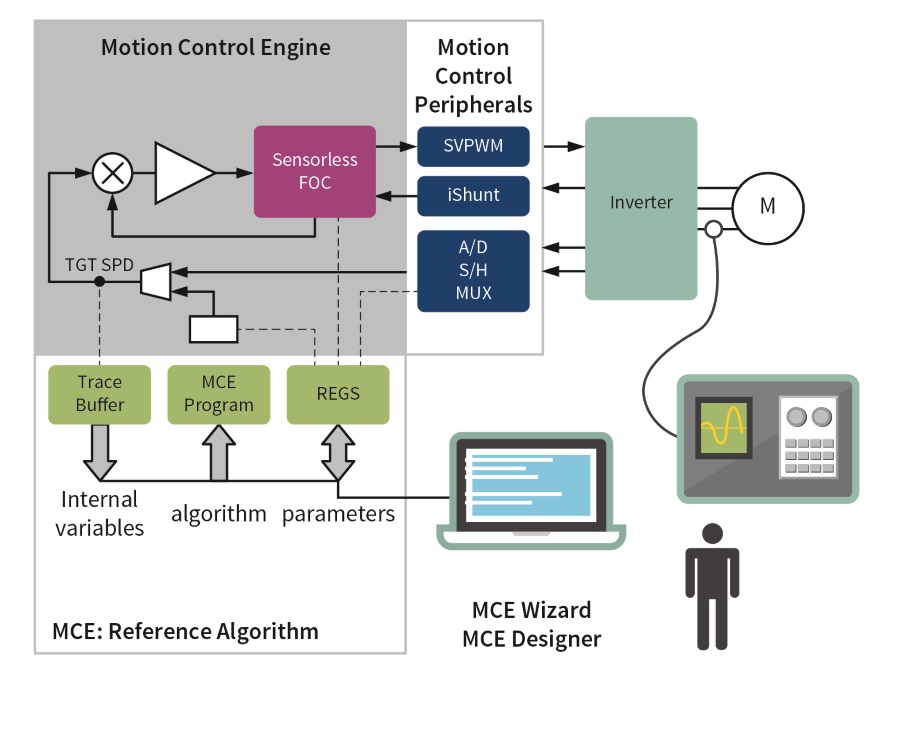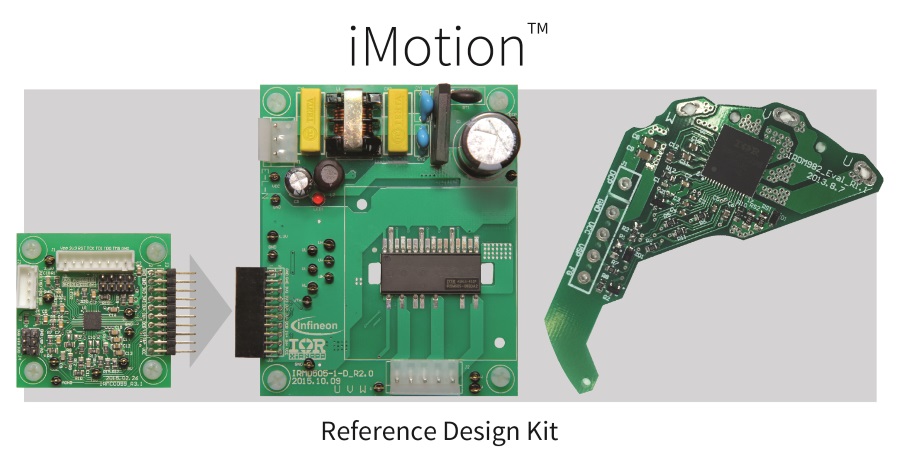By INGO SKURAS
Senior Specialist, iMotion Product Marketing
Infineon Technologies
www.infineon.com
Designers of motion control applications are under pressure to optimize performance and efficiency while keeping component count and space to an absolute minimum. The ideal situation is sensorless control of the permanent magnet synchronous motors (PMSMs) used in these applications, but such control is complex and has traditionally required extensive design and coding skills to develop the appropriate algorithms.
In recent years digital IC technologies have been introduced that reduce the coding burden on the designer. With the latest evolution of advanced semiconductor controllers and support tools it’s now possible to implement sophisticated sensorless control schemes without the need to program any code at all.
In general, PMSMs offer several advantages over other motor types. The lack of a commutator makes the PMSM more reliable than a DC Motor. And by generating the rotor magnetic flux with permanent magnets, the PMSM is more efficient than an AC induction motor that requires both magnetization and stator current. As a result, PMSMs can be found in the home, in industry, in automotive and in aerospace applications. Typical household applications would include white goods such as refrigerators, dishwashers or washing machines. In industry, the PMSM can be found in a variety of applications including robotics, fans, pumps, hoists, power tools, textile machines and hand tools. PMSMs can also be found in electric and hybrid cars, and the combination of reliability and efficiency makes them well-suited to the latest genre of vehicle – drones.
Benefits of sensorless field-oriented control (FOC)
FOC is a mathematical vector control technique for controlling both AC and brushless DC motors. A large advantage when compared to alternative open loop control is that FOC allows measurement and control of torque. FOC deals with flux and torque vectors as two loops running in parallel. Thus when used in an AC induction motor, especially at lower speeds, FOC can improve efficiency as the decoupling of the magnetizing flux and torque producing current allows for more precise control of both elements.
FOC is particularly useful for PMSM systems as it provides an efficient way to control a synchronous motor in a variable speed drive or other applications that have very dynamic loads. It also is possible to eliminate the sensor (typically an encoder) and provide closed loop control without adversely increasing system cost. The removal of the sensor also eliminates the associated wiring, weight and energy usage resulting in a more efficient, compact and reliable solution.
Compared to AC induction, engineers start with greater efficiency in a permanent magnet system, such as a brushless DC motor because no current is needed to generate rotor magnetic flux. The precise linear control provided by FOC better supports variable speed operation and reduced torque ripple translates to quieter operation of fans due to smoother motor performance.
Challenges of implementing FOC control schemes
With all of the associated equations, FOC is more complex to understand than commutation – at least initially. However, peeling back the mystery reveals a simple control loop and four principle steps to implementing an FOC-based motor control system; i) the current flowing in the motor is measured ii) this is compared to the control input (desired current) iii) the difference is amplified and used as a control voltage signal iv) the control signal is applied to the motor via a modulation process.
The major challenge with implementing FOC is managing the trade-offs between required system performance and cost. A simple shunt in each phase of the motor or a single shunt on the DC link path may suffice for a basic motor control drive.
The overall system precision is a function of the resolution of the system ADC (10 bits is typical although 12 bits can be used in high-precision applications) and also the speed of the control loop (10kHz works for many applications and 20kHz is commonly used for more precision). However, higher bit count and higher operating frequencies require greater processing power, thus entailing more cost.
Platform approach simplifies integration
With the advent of integrated design platforms, engineers now have an easy path to implementation of a sensorless FOC system for any variable-speed three-phase motor application. All necessary control algorithms can be embedded in the control IC. A configuration utility enables users to quickly get the motor running and move to application testing and hardware design more rapidly than with traditional design approaches.
An example of this approach is the IRMCK099 (Fig. 1 ), a low-cost, high-performance OTP memory based motion control IC designed primarily for sensorless motor control applications. Unlike earlier motor control ICs that required some programming of the MCU element, this IC features a Motor Control Engine (MCE) with control algorithms (based on standard library blocks) included in firmware along with a hardware accelerator. This MCE implements sensorless FOC in both interior and surface PMSMs using single or leg shunt current feedback through a combination of hardware and firmware elements.

Fig. 1: Block diagram – IRMCK099 motion control IC
The control IC incorporates all major system elements in a 5mm x 5mm, 32pin QFN package that operates from a single 3.3V supply. A built-in ADC offers 12bit resolution and a rapid 2μS conversion time, making it ideal for precision applications. Alongside the advanced ADC is a 100 MHz internal oscillator that removes the need for an external clock. A Sigma Delta DAC provides a two-channel analog output and all analog inputs are factory calibrated. Along with 16-kB of on-board OTP memory with a CRC memory check, the device features advanced communication and interface subsystems including a 57.6kBps UART, 8 digital GPIO ports, 6 PWM outputs and an I2 C interface. Four register-selectable control inputs enhance design flexibility by supporting motor speed and direction control via UART, analog voltage, frequency or duty cycle. This ensures simplified interfaces within a wide variety of applications.
The single shunt reconstruction feature allows the accurate current measurement needed for FOC control to be achieved with a single external shunt, thus minimizing external analog and digital circuitry. Phase shift PWM eliminates the minimum pulse limitation, improving motor start at low speeds and reducing acoustic noise in operation.
Other built in safety and protection features include rotor lock protection and catch spin to detect any rotation of the motor before a control input is applied.
“No Code” implementation
Compared to MCU or DSP-based FOC designs, the dedicated IC approach makes it possible to realize a motion control design without programming.
Parameter calculations can be performed using a GUI-based drive configuration and design tool (Fig. 2 ). It starts with a simple form-based dialog box that captures all motor parameters and application information such as speed and acceleration in an easy-to-understand, engineer-friendly format – along with text and pictures where needed. Once complete, the parameters are automatically exported to a design tool. This tool facilitates drive testing and parameter tuning. The engineer can start and stop the motor as well as achieving best performance by optimizing drive parameters under load allowing meaningful editing of data in individual control registers. A powerful parametric trace tool allows the user to trace and plot internal control variables, thus rapidly debugging and improving the drive performance.

Fig. 2: iMOTION provides a simplified design process for Field Oriented Control of motors

Fig. 3: The iMOTION reference design board allows easy migration from design to production
Rapid development of motor control systems is further supported by a range of development and support tools, including reference design boards (Fig. 3 ). The RDB on the left is a motor control system incorporating the control IC and an intelligent power module (IPM) along with all necessary components and the RDB on the right features a smart µIPM.
Advertisement
Learn more about Infineon Technologies





